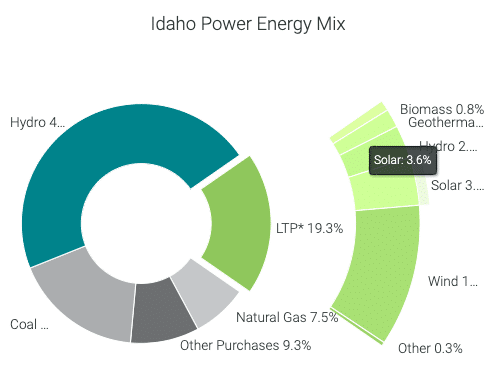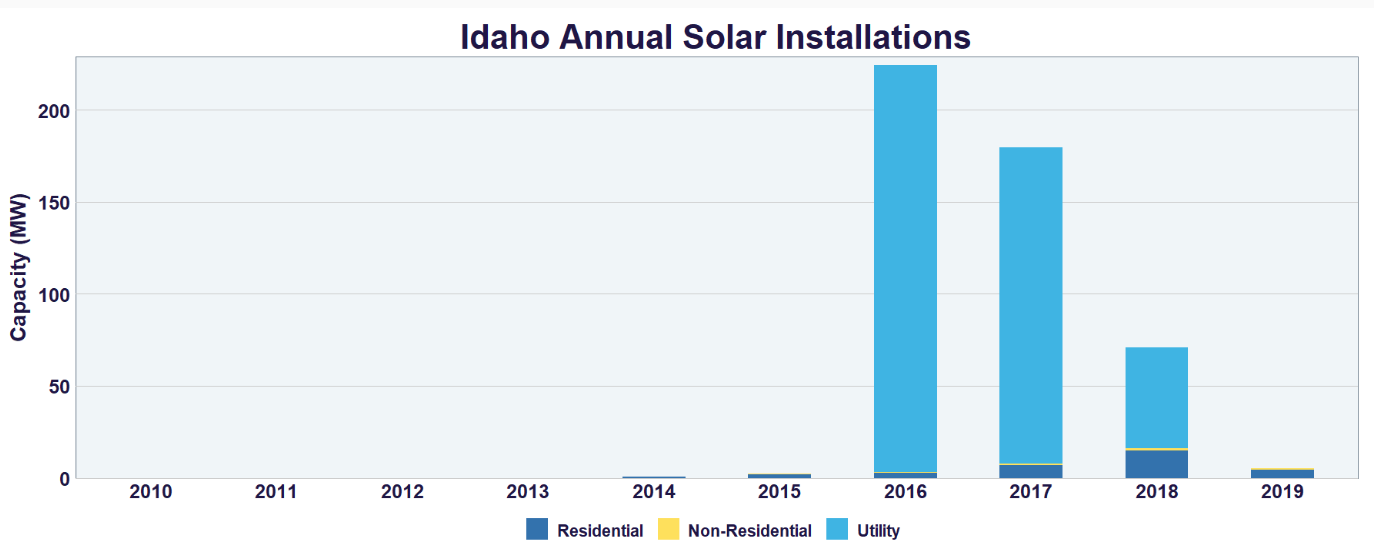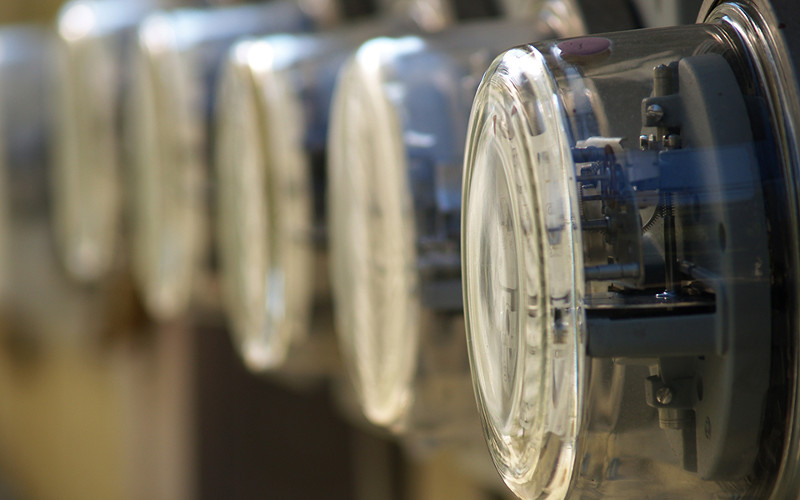Another chapter has been written in residential solar’s most-read book: Utilities vs. Distributed Generation. This time the setting is Idaho, current day, as Idaho Power Company has proposed to state regulators a measure to decrease the rate that solar owners receive for their excess solar generation by 50%.
This is one of the two most common ways that utilities attempt to undermine residential solar, with the other being via monthly fixed charges, like a “grid access charge” or whatever the utility in charge choses, they’re all essentially the same mechanism.
In this instance, Idaho Power is arguing that “the standard rate paid has failed to properly recover the costs incurred to serve customers with on-site generation,” which is the most common reasoning when utilities chose the “decrease net metering’s value” avenue of attacking residential solar.
This methodology is one that has been repeatedly disproven, including in an analysis by Brookings Institution in 2016, which found that, in most instances, net metering is in fact a net benefit to ratepayers. Now, in the spirit of fairness, the cost shift argument is not always an illogical one. Lawrence Berkeley National Lab has found that there actually is a cost-shift when solar penetration levels rise to around 10% of total annual power on the system.
The reality is that solar currently serves less than 3.6% of demand in Idaho Power’s energy mix.

If approved, this proposal could prove to be a death blow for the already weak residential solar industry in Idaho. To date, the state has a total of 448 MW installed solar capacity, 52 of which come from residential solar units.

This is not the first attempt to rid itself of the ‘burden’ of net metering that Idaho Power has made this year alone. In April, the utility asked the Idaho Public Service Commission (IPUC) for permission to rid itself of Schedule 84, the net metering provision it created under orders from IPUC. Before that, in 2017, Idaho Power used the same cost-shift argument when presenting before regulators an application to get rid of net metering.
What’s most interesting is that these attacks on net metering are coming from a utility which was the second utility in the United State to announce a goal to transition to 100% clean energy by 2045. However, as utilities have been quick to find out, there are plenty of ways to increase the penetration of ‘clean’ generation sources without those sources including residential solar. Utilities are also free to define what ‘clean’ generation means to them, with sone including nuclear energy and natural gas in that designation.
Idaho Power is not clean in terms of what types of generation it does consider ‘clean,’ but hydroelectric is most definitely included. As the first graphic above shows, hydropower supplies nearly half the power on the utility’s system, with wind, solar, biomass, geothermal and all other renewable resources combining for just over 19% of the power mix.
The fate of the relatively weak Idaho residential solar market could be hanging in the balance of this application before our very eyes. This could be the end, or just another turn in the game of net metering cat-and-mouse between Idaho Power and state regulators.
This content is protected by copyright and may not be reused. If you want to cooperate with us and would like to reuse some of our content, please contact: editors@pv-magazine.com.









As the owner of a 5.5kW system in NC, I’ve found net metering to be a minor issue with little economic impact. I typically sell about $10 a month back to the grid. Before they increased the fixed charges for solar, I’d have earned about $15.
Either way not enough dollars to impact a decision to go solar.
The elephant in the room needs to be discussed.
When is the residential consumer going to be allowed full access to rooftop solar?
That is availability of product inventory currently being consumed by investor utility purchasers; standardized mounting systems such as in Europe, true costs recognizing LCOE that utilities are realizing, and plug and play systems to be installed by consumers, and connected by local electricians.
Let’s get to a buck a KWh as soon as possible so a 10Kh system can compete with an ATV which depreciates from the get go
Energy choice for the consumer is still not a reality.
Let’s be honest here.
Energy “choice” has been available for the ratepayers for the last 10 years at least. Solar PV with energy storage for self consumption is the new buzz word. Iron Edison racking systems have come down from $55 a panel to around $35 a panel. The larger solar installation companies are beginning to sell combined ‘systems’ of solar PV with energy storage as a unit, that will extend one’s solar PV harvest of energy into the night time hours. The solar PV could be stored and used for 12 to 16 hours and the ESS could be used with smart algorithms to use arbitrage to charge the battery pack late in the evening and early in the morning with off peak or super off peak power to use before the sun comes up the next day.
Your point of installing systems and only needing an electrician to hook it up to the C.B. panel is getting close to reality. There used to be three or four known residential energy storage system companies just 5 years ago. Now there are about a dozen ESS companies available to install energy storage on one’s home, or business. Now the LCOE is becoming “programmable” depending on what type or types of electric rate programs the utility uses. Does the utility have tiered electricity rates? Does the utility have net billing instead of net metering? Does the utility invoke TOU or demand rate spiking during part of the day? all of these things a smart ESS can address now and in the future.
A couple years ago we recently installed solar panels to our home to do our part to reduce fossil fuel consumption that has resulted in global warming and enormous environmental damage from mercury emissions and other air or water borne pollutants. Institutions and utilities should be encouraging this move towards alternative energy sources and not penalizing those who feel we can do better to sustain our planet and way of life. In addition, Idaho Power did not help fund our solar installation which was a major cost for us. This is all the more reason why they should not be attempting to profit from home solar installations. As an existing solar energy producer we feel it is only fair that we be grandfathered in under the original terms of our investment.
Idaho Power’s proposal is unfairly singling out solar customers which only make up less than 0.5% or just 2,000 of 560,000 total Idaho customers. The Company contends that because net-metering solar customers reduce the number of kilowatt-hours they purchase from the utility they avoid paying their fair share of fixed costs. But there have always been different types of customers that cost more and less to serve yet pay the same rates including rural and urban customers. Net-metering solar customers also provide power to their neighbors and can help reduce the need for expensive transmission and distribution infrastructure necessary to move electricity from power plants that may be hundreds of miles away. This is especially true during summer when peak power demand is highest, which coincides with peak output from solar systems that can supplement our local power needs.
If the Company wants to look at cost shifting, they need to take a much broader look at the issue rather than just focus on the tiny changes that net-metering may make. Idaho Power has a goal of 100% clean energy by 2045…so why are they attempting to penalize those who are doing their fair share to reach such a goal. One final issue that is especially troubling to me is Idaho Power’s claim of generating “clean energy” from their operation of hydroelectric facilities at dam sites. This energy source is certainly better than dirty fossil fuels; however, it comes at a tremendous cost to society of about $17 billion in programs to recover salmon which has been ineffective to date. Just ask folks from Riggins, Idaho, where recreational fishing is an important source of income, how the salmon and steelhead fishery is doing these days. Marine and riverine ecosystems have also suffered as a result of these keystone species decline.
For your information, solar now employs more people in the U.S. electricity generation than oil, coal and gas combined. Idaho needs to pass legislation to offer more incentives to encourage solar systems…so many new developments in the Boise Valley without solar… what a shame and missed opportunity. Your proposal may jeopardize this growing industry in Idaho and cast a shadow of uncertainty in the marketplace.
@Terry Maret, this is the desperate attempt of the electric utilities to hold onto their uni-directional grids and services. IF the utility can’t control the distributed solar PV system, then they can’t control the flow and price of electricity. As you have stated only 0.5% of personal solar PV adoption and Idaho Power sees the writing on the wall. If the utility can’t dilute the value of independent solar PV on one’s home then there will be a “duck curve” during the solar PV generation hours amounting at times of electricity at a negative price per MWh produced during the peak solar insolation of the day. The next step in Idaho is for past and future solar PV adopters to install a smart energy storage system. Becoming self consuming of your own solar PV generation will give you value over what the utility wants to pay you for and allows more personal use of the solar PV generated during the day. IF 50,000 more folks would install their own solar PV with ESS, Idaho Power might just realize how powerful a resource an aggregate distributed grid really is.